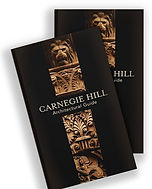Historic Preservation
Our commitment to preservation is about more than buildings—it’s about protecting the integrity, livability, and legacy of the place we call home.
























Carnegie Hill Neighbors has long played a vital role in protecting the charm and character of our neighborhood through historic preservation. This work has helped shape our community—leading to the creation of historic districts, landmark designations, and the responsible down-zoning of key corridors.We believe in thoughtful, contextual development that respects the unique architecture and scale of Carnegie Hill.
What Do Preservationists (Like CHN) Do?
-
Speak at community meetings
-
Write letters and petitions
-
Work with experts and city agencies
-
Use the media to raise awareness
-
Support smart, respectful renovations
When a project threatens to disrupt that harmony, we take action. Whether it’s launching letter-writing campaigns, speaking out at Community Board meetings, or working alongside preservation partners and policy experts—we advocate for smart, community-driven solutions.
Historic Preservation 101:
What It Is & Why It Matters
Historic preservation means protecting the buildings, streets, and open spaces that tell the story of our community’s past. It's about keeping the character and charm of a neighborhood intact—even as the city grows and changes. Preservation isn’t about stopping change—it’s about guiding it. When we protect the right pieces of the past, we build a richer, more beautiful future.
Why Its Important
-
Our buildings tell our story. They show how people lived, built, and dreamed—whether it’s a brownstone, a church, or a quirky old storefront.
-
Preservation keeps our neighborhoods unique. Without it, we risk losing what makes our area special (and becoming just another row of glass towers).
-
Studies show that historic areas often hold or increase their value more than others.
-
It’s sustainable. Reusing and maintaining old buildings reduces construction waste and carbon emissions.
-
Preserving light, air, and open space: Keeps neighborhoods from feeling too dense or dark.

Glossary of Terms
Zoning - Zoning laws control what can be built and how big it can be. They help make sure a giant skyscraper doesn’t pop up in the middle of a row of small homes. Preservation advocates, like CHN, often push for “contextual zoning” so new buildings fit in with their surroundings.
Historic Districts - These are groups of buildings—like an entire street or neighborhood—that are protected together. They create a sense of place and a shared identity. Living in one means any new development has to match the area's look and feel.
What this distinction means:
Protection from demolition or inappropriate changes
-
You can’t demolish, alter, or build on the exterior of a property in a historic district without LPC approval.
-
This ensures new construction or renovations fit the character of the neighborhood.
Preservation of architectural details
-
Original materials, façades, and design features must be maintained or replicated during work.
-
Even things like windows, signage, or rooftop additions are subject to LPC review.
Recognition of cultural and architectural value
-
It formally acknowledges the area's importance to NYC’s history and built environment.
-
Historic districts often reflect key architectural styles or represent a specific era or community story.
Certificate of Appropriateness (CofA) required
-
Property owners must apply for a CofA from the LPC before making changes that affect the building’s exterior.
Landmarks - A landmarked building is protected because of its historical, cultural, or architectural importance. Unlike historic districts, which cover groups of buildings, landmark status applies only to a specific property—a church, townhouse, school, etc. You can’t tear it down or make big changes to the outside without approval.
Explore even further with the
Carnegie Hill Architectural Guide

Spanning 396 pages, this volume is richly illustrated and packed with detailed architectural descriptions of more than 400 buildings—capturing every nuance and characteristic along each block.
For those eager to explore further, the book includes an outstanding “Carnegie Hill Walks” section, featuring maps and narratives for eight self-guided tours. Whether you’re discovering the neighborhood for the first time or rediscovering it anew, this book extends a warm invitation: Welcome to Carnegie Hill.
How to Make Exterior Changes to a Building in a Historic District
Living in a historic district means your property is part of a protected area where the exterior appearance contributes to the neighborhood’s architectural character.
That’s great for preserving charm—but it also means you need permission before making any visible changes.
1. Find Out Your Home’s Landmark Status
-
Check if your property is:
-
Individually landmarked
-
Within a historic district
-
-
In NYC, search via the Landmarks Preservation Commission map
2. Know What Changes Require Approval
-
Any work visible from the street typically requires review.
Examples:-
Painting the façade a new color
-
Replacing windows or doors
-
Installing a fence, railing, or awning
-
Adding lighting, signage, or security cameras
-
Changing roofing, siding, trim, or front steps
-
3. Contact the Preservation Agency
-
In Carnegie Hill: reach out to the Landmarks Preservation Commission (LPC) by visiting their website at https://www.nyc.gov/site/lpc/
They’ll tell you:
-
What kind of permit you need
-
What materials to submit
-
If your proposed work is eligible for staff-level approval (fast) or needs a hearing (longer)
4. Prepare and Submit Your Application
-
You’ll likely need:
-
Photos of current conditions
-
A description of the proposed work
-
Material samples or paint swatches
-
Drawings or renderings (especially for major changes)
-
5. Wait for Approval Before Starting the Work
-
Skipping this step can lead to:
-
-
Fines
-
Stop work orders
-
Being required to undo the work at your expense
-
Tips:
Hire a Contractor Familiar With Landmark Rules
-
This ensures work is done correctly and won’t create compliance issues down the line.
Keep Good Records
-
Save your permit documents in case you ever need to show proof of approval (e.g., during a sale or inspection).
Historic Districts
Explore Carnegie Hill Designation Reports from our archive:
Individual Landmarks
Explore landmarks in Carnegie Hill:




